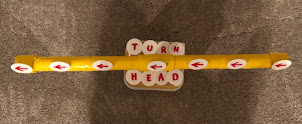Ready, Set, CUE!
In my neuro aspects class, one assignment that I worked on was the media project. This is where each student is presented with a case study of a client with a neurological deficit impacting their occupational performance. We students then have to fabricate a device or tool that can be used during an intervention session or as an adaptive device using household items. For the case study, I was assigned, my client is diagnosed with right cerebral vascular (CVA) of the internal carotid artery with left neglect. CVA is just a fancy name for a stroke, and left neglect is a term describing a deficit in awareness/difficulty paying attention to items falling in the left hemisphere or just a general lack of awareness of anything on the left side. Prior to the diagnosis, my client had been very active. He recently retired as a postal worker, and he is an avid gardener and woodworker. The goal of the client is to return home after his discharge from the rehabilitation hospital and continue his hobbies. Other deficits identified in the client included: visual perception, with challenges in figure-ground and spatial relations, right/left confusion, left neglect, poor attention span, insight, judgment, and safety awareness, and constantly bumping into things on his left side.
The three materials I was assigned for this assignment were: duct tape, poker chips, & a margarine tub. Out of these materials, I created a cueing device (pictured below). I used all three materials plus some PVC pipe. All the materials used cost roughly around $6 - $7. To build the actual device, I connected the PVC pipe in the shape of the letter T. I then wrapped the PVC pipe in duct tape. I made sure to use a concentrated yellow color duct tape to grab the client's attention, enough to look at the device but not to distract them. Next, I used the margarine tub as the base. I cut a hole in the tub and placed the end of the PVC pipe in there, so it is standing. I also wrapped the tub in duct tape so that the words that were originally printed there wouldn't distract him. Lastly, I attached the poker chips on top of the PVC pipe and on the margarine tub. The poker chips on top of the PVC pipe have arrows drawn (in red) to the left and the poker chips on the margarine tub have the words " turn head" written on them (in red).
In this case study I wanted to focus more on the left neglect and attention deficit therefore I thought a cueing device would be great for this client. Gardening and woodwork require someone to be cautious of their surroundings, whether it's safety, attending to work to the left/right side, or even communication. When the client is performing these hobbies, they can simply put the device in front of them, most likely the right side since he does not have any awareness of the left side) to cue them to turn their head to the left. This "tool" would fall in the assistive technology category; therefore, it is a form of adaptive equipment. This project has supported my OT learning in many different ways. It required me to use my problem-solving skills while also being creative. There were many factors that I had to consider while brainstorming ideas. I had to keep in mind the needs of the client, what they enjoy, their diagnosis, strengths/areas of improvement, etc.
Occupational therapy is known to be a creative profession both as a practice and in its use of creative DIY projects/activities to help clients with occupations!




Comments
Post a Comment